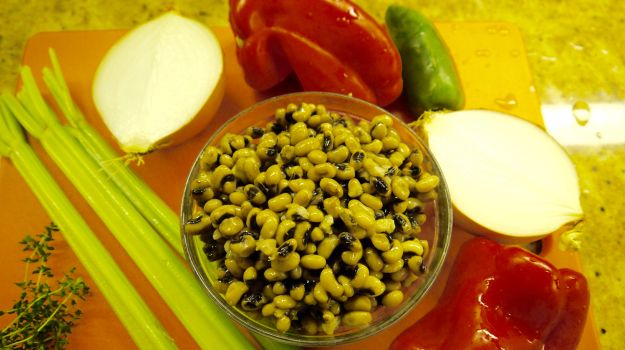Credit: Copyright 2015 Brooke JacksonThe New Year's holiday is a time of closure and new beginnings. Resolutions are a common rite of New Year's Eve, with people making goals for the coming year and raising a glass to the old one. A dinner of foods representing good fortune then completes the tradition in many cultures.
Around the world, foods are eaten on New Year's Eve and New Year's Day that are auspicious and thought to bring prosperity for the coming year. The ingredients are often chosen for their resemblance to money: coin-shaped legumes and winter greens that look like bills, to name a couple.
In Europe and Asia, fatty, rich pork is considered a lucky food because a pig roots for food in a forward direction, charging into the future and obviously getting plenty to eat. In Italy, a traditional dish is cotechino con lenticchie -- juicy pork sausages paired with lentils. The cotechino sausage is fatty and represents abundance, while the lentils' roundness and green color bring to mind money.

Credit: Copyright 2015 Brooke JacksonIn Asia, long noodles are slurped to guarantee long life, the caveat being that the noodle can't break before being swallowed. In some cultures, people bake treasures or money into desserts and treats.
In England, a sixpence is steamed in the Christmas pudding; whoever gets the portion containing the coin will have a prosperous year. In Mexico, a traditional King Cake is baked with a small doll in the batter; the lucky diner who gets the doll in their piece of cake gets to be king for a day.
Many cultures celebrate the New Year by eating ring-shaped food such as bagels or doughnuts. The shape is thought to bring good luck by representing the year coming full circle.
In Spain and Portugal revelers eat 12 grapes at midnight, and the grapes must be consumed before the last stroke of the midnight bell. Each grape represents a month of the year, so if the fourth grape is extra-sweet, for example, this could mean April will be a terrific month.
U.S. traditions for ringing in new year are varied
In the United States, the melting pot of cultures adds many choices to New Year's celebrations. Often decadent or expensive victuals such as caviar and Champagne are consumed, with the pricey roe of the sturgeon thought to bring prosperity.
Throughout the South, Hoppin' John is served on New Year's tables. Black-eyed peas with rice are thought to bring luck because the peas are round like coins and the rice grains swell -- like your wallet, not your waistline -- when cooked. Often served with a mess of greens meant to emulate dollar bills, this is good old-fashioned down-home fare.

Credit: Copyright 2015 Brooke Jackson
The recipe for Hoppin' John included below has some peppers and spice for heat, but you can temper that by using less jalapeo. I like the pre-soaked black-eyed peas and steamed black-eyed peas from Melissa's produce company, which can be found this time of year in the produce section of grocery stores. If you can't find either of these, use canned black-eyed peas and rinse them.
The menu is rounded out by a salad of spicy greens, like dollar bills, with pomegranate seeds for abundance, satsumas for luck and grapefruit for flavor. The dressing is made with fig vinegar, whose plentiful seeds must surely mean prosperity. If you can't find a ready-made version, I've included an easy recipe adapted from "Fig Heaven" by cookbook author Marie Simmons.
After this dinner, good fortune will surely be smiling down on you. Wishing everyone a New Year full of health, good fortune and peace.
Hoppin' John
Southern-style cornbread, with buttermilk and just a little sweetness, is a natural choice to eat with Hoppin' John.
Prep time: 20 minutes
Cook time: 1 hour
Total time: 1 hour, 20 minutes
Yield: 6 servings
Ingredients:
2 tablespoons olive oil
1 medium onion, chopped
3 ribs celery, chopped
2 medium red bell peppers, diced1 jalapeno pepper, minced (or more or less to taste)
3 cloves garlic, minced
2 (11-ounce) packages fresh black-eyed peas or steamed black-eyed peas (Melissa's, for example) or 2 (15-ounce) cans black-eyed peas, drained and rinsed
1 meaty ham hock or ham bone
1 bay leaf
1 can diced tomatoes with green chiles, undrained
2 teaspoons Cajun or Creole seasoning
1 teaspoon fresh thyme
1/2 teaspoon cumin
1/2 teaspoon salt
1/2 cup water, or as needed
For serving:
2 cups hot, cooked long grain rice
4 green onions, green and white parts, thinly sliced
Directions:
1. Heat the oil in a large pot over medium high heat. Add the onion, celery, bell peppers and jalapenos and sauté until the vegetables are soft, about 5 minutes.
2. Add the garlic and stir until fragrant.
3. Add the rest of the ingredients and enough water to make the mixture soupy.
4. Bring to a boil then reduce the heat to low; cover and simmer for 1 hour, stirring occasionally, until the flavors are combined.
5. Check liquid level periodically and add more water if the peas are getting too dry.
6. Remove the ham hock and cut off the meat. Dice the meat and add it back to the pot.
7. Serve over white rice with a shower of green onion on top.
Citrus Salad With Fig Vinaigrette
Prep time: 20 minutes
Total time: 20 minutes
Yield: 6 servings
Ingredients:
For the dressing:
1 tablespoon fig vinegar (see note and recipe below)
3 tablespoons walnut oil
Salt and pepper to taste
For the salad:
2 packed cups baby spinach leaves
2 packed cup arugula
2 satsuma tangerines, peeled and sectioned
1 large ruby red grapefruit, peeled and sectioned. Remove as much white pith as possible
1/4 cup pomegranate seeds
Black pepper
Directions:
1. Make the dressing by putting the vinegar in a small bowl and gradually drizzling in the walnut oil, whisking constantly, until an emulsion forms. Taste and season with salt and pepper.
2. Place spinach and arugula in a medium salad bowl and toss with enough dressing to just coat the leaves.
3. Distribute salad among six plates.
4. Divide the satsuma and grapefruit sections among the salad plates and then evenly then sprinkle each salad with the pomegranate seeds.
5. Drizzle a bit more dressing over each plate and finish with a few grinds of fresh black pepper. Serve immediately.
Note: If you don't want to make the fig vinegar, you can substitute fig balsamic vinegar or a good-quality aged balsamic vinegar.
Fig Vinegar
This recipe is adapted from "Fig Heaven" by Marie Simmons. It is a wonderful gift to share with friends.
Prep time: 15 minutes
Cook time: 5 minutes
Rest time: About 24 hours
Total time: About a day, but only 20 minutes active.
Yield: About 2 cups
Ingredients:
3 cups red wine vinegar
6 ounces dried Calimyrna or Black Mission figs, stems trimmed and cut up (about 1 cup packed)
1/4 cup sugar
1 cinnamon stick
Directions:
1. Combine the vinegar, figs, sugar and cinnamon stick in a medium saucepan and heat to a boil.
2. Reduce the heat to low and cook, covered, for 5 minutes.
3. Let stand 24 hours. Strain the vinegar, pressing down on the figs to extract their flavor.
4. Reserve half the figs; discard the remaining figs and the cinnamon stick.
5. Purée the vinegar and the reserved figs in a food processor. Line a strainer with a doubled layer of dampened cheesecloth and set it over a bowl.
6. Pour the puréed vinegar mixture into the cheesecloth-lined strainer and press down on the solids. Let drain for 30 minutes.
7. Transfer the strained vinegar to a jar and store in a cool, dark place or in the refrigerator.







